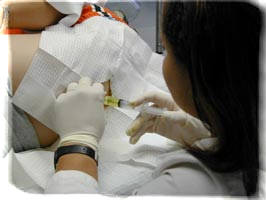



Bloodborne Pathogens (BBP) Definition

Pathogenic - Capable of causing disease
Microorganism - Any organism that cannot be seen by the unaided eye (microscope, lens etc.)


Bloodborne Pathogens can be transmitted through:


Spinal fluid being extracted during a lumbar tap
Bloodborne Pathogens
NEXT
CSF - A clear fluid that occupies space in and around the spinal cord and brain. Essentially the brain "floats" in it.
Synovial fluid - A thick, stringy fluid found in the cavities of synovial joints. With its egg-like consistency ("synovial" partially derives from ovum, Latin for egg), synovial fluid reduces friction between the articular cartilage and other tissues in joints to lubricate and cushion them during movement.